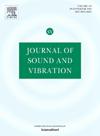Vibration enhancement for fiber-optic acoustic sensors via Helmholtz resonator-membrane synergy
IF 4.3
2区 工程技术
Q1 ACOUSTICS
引用次数: 0
Abstract
The vibration-responsive membrane enables effective and sensitive sound wave capture, and enhancing membrane vibration is essential for optimizing sensor performance. Typically housed within an acoustic chamber to protect against external disturbances, the membrane's interaction with a carefully engineered chamber provides a promising pathway to improve sound-induced vibration. Here, we propose a design paradigm that effectively enhances membrane vibration by exploiting the synergy between the Helmholtz resonator and membrane dynamics. The complex modal analysis incorporating acoustic impedance and mass corrections is developed to characterize the synergistic vibration behavior of the Helmholtz resonator-coupled membrane, validated through finite element analysis and experimental testing. We apply the Helmholtz resonator-membrane synergy into a fiber-optic acoustic sensor prototype with a 50 μm-thick flexible polymer membrane, achieving a maximum sensitivity of 654 nm/Pa (-104.05 dB re rad/μPa), together with a minimum detectable sound pressure down to 7.7 μPa/. This synergy-enabled vibration enhancement provides a straightforward and efficient method for optimizing sensitivity and extending bandwidth, demonstrating strong potential for advanced acoustic detection applications.
通过亥姆霍兹谐振腔-膜协同作用增强光纤声传感器的振动
振动响应膜能够有效灵敏地捕获声波,增强膜振动对于优化传感器性能至关重要。这种膜通常被安置在一个声学室中,以防止外部干扰,它与一个精心设计的腔室相互作用,为改善声诱发振动提供了一条有希望的途径。在这里,我们提出了一种设计范例,通过利用亥姆霍兹谐振器和膜动力学之间的协同作用,有效地增强膜振动。结合声阻抗和质量修正的复杂模态分析被开发来表征亥姆霍兹谐振腔耦合膜的协同振动行为,并通过有限元分析和实验测试进行验证。我们将亥姆霍兹谐振腔-膜协同作用应用于50 μm厚柔性聚合物膜的光纤声传感器原型中,最大灵敏度为654nm /Pa (-104.05 dB re rad/μPa),最小可探测声压降至7.7 μPa/Hz。这种协同增效的振动增强为优化灵敏度和扩展带宽提供了一种简单有效的方法,展示了先进声学探测应用的强大潜力。
本文章由计算机程序翻译,如有差异,请以英文原文为准。
求助全文
约1分钟内获得全文
求助全文
来源期刊

Journal of Sound and Vibration
工程技术-工程:机械
CiteScore
9.10
自引率
10.60%
发文量
551
审稿时长
69 days
期刊介绍:
The Journal of Sound and Vibration (JSV) is an independent journal devoted to the prompt publication of original papers, both theoretical and experimental, that provide new information on any aspect of sound or vibration. There is an emphasis on fundamental work that has potential for practical application.
JSV was founded and operates on the premise that the subject of sound and vibration requires a journal that publishes papers of a high technical standard across the various subdisciplines, thus facilitating awareness of techniques and discoveries in one area that may be applicable in others.
 求助内容:
求助内容: 应助结果提醒方式:
应助结果提醒方式:


